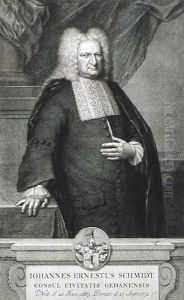Jacobus Houbracken Paintings
Jacobus Houbraken was a Dutch engraver and the son of the artist and biographer Arnold Houbraken, whom he assisted in producing a published record of the lives of artists from the Netherlands. Born on December 25, 1698, in Dordrecht, Jacobus developed his skills under the tutelage of his father and became renowned for his portrait engravings, which were often used as frontispieces in books.
His most significant contribution to the arts was his work on the multi-volume series 'The Heads of Illustrious Persons of Great Britain,’ which he collaborated on with the historian Thomas Birch. This work, published in London between 1743 and 1752, featured a collection of engraved portraits of notable British figures. Houbraken's engravings were based on paintings by famous artists such as Peter Lely, Godfrey Kneller, and others, and they played a key role in preserving the likenesses of these historical figures.
Apart from 'The Heads of Illustrious Persons of Great Britain,' Houbraken also worked on portrait engravings for Jan van Gool's 'Nieuwe schouburg der Nederlantsche kunstschilders' (The New Theatre of Dutch Painters), which was a continuation of a similar work by his father. Throughout his career, Houbraken's engravings were highly prized for their quality and detail, and they served as an important visual record of cultural and historical personalities of the time.
Jacobus Houbraken's work was characterized by a meticulous attention to detail and a clear, precise line. His engravings often included elaborate decorative elements surrounding the portrait, which added to the grandeur of the image. Despite the prominence of his work during his lifetime, Jacobus did not achieve the same level of lasting fame as some of his contemporaries in the realm of painting. Nevertheless, his engravings remain valuable to historians and art collectors.
Jacobus Houbraken passed away on November 14, 1780, in Amsterdam. His legacy lives on through his contributions to the art of engraving and his role in documenting the visages of historical figures. His works are held in the collections of many major museums and libraries around the world, continuing to be studied and admired for their historical significance and artistic merit.










